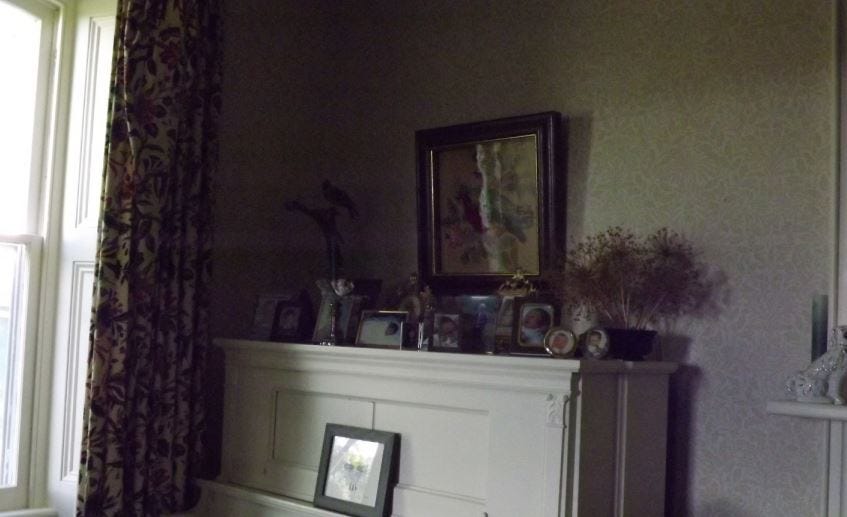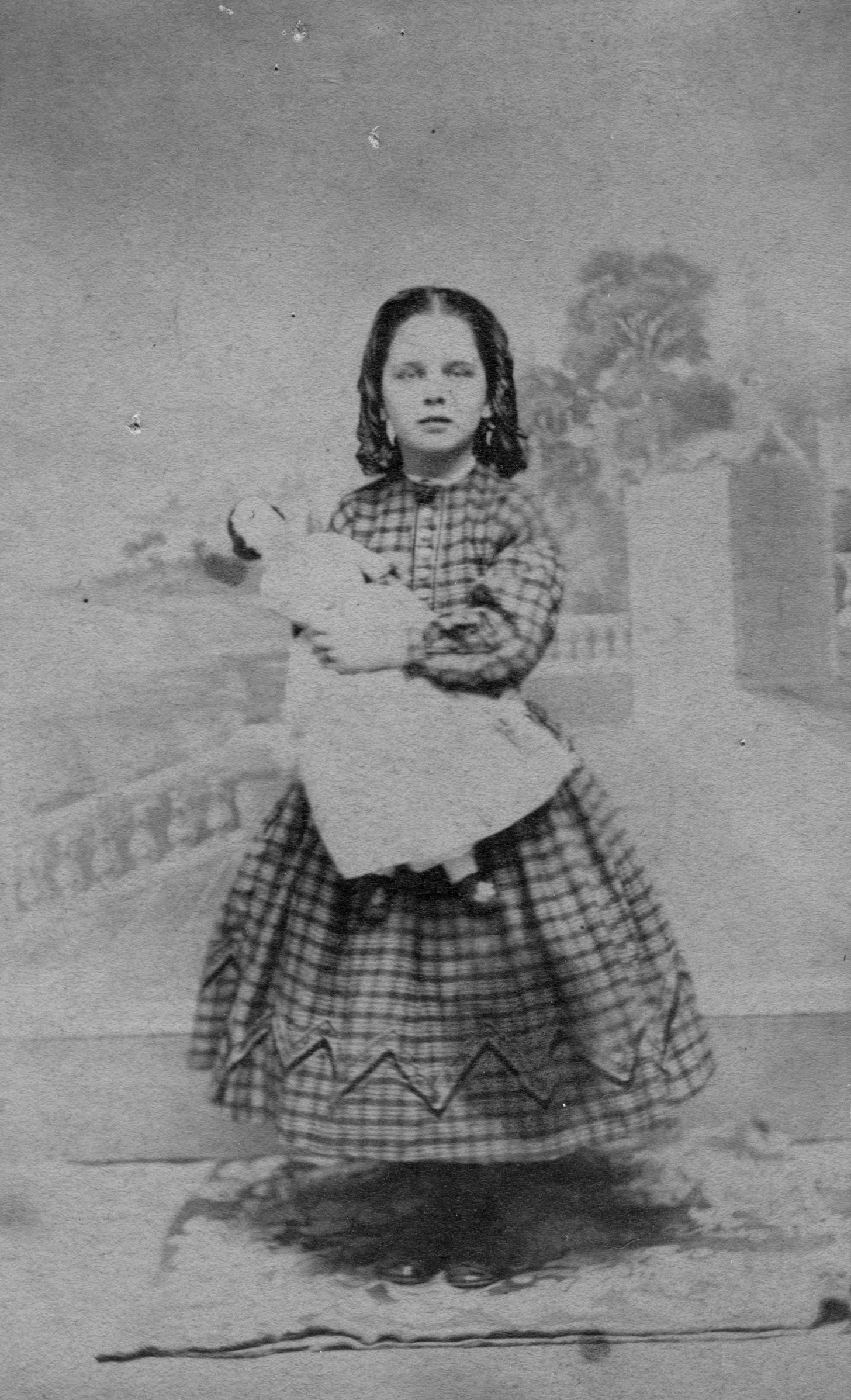This is a terrible picture. I took it in 2017 when I was on the family farm, not thinking of showing it to anyone. I was gathering evidence.
My mother was not well. I was staying with her, trying to be helpful. But much of the time I was idle, walking in the woods or rifling old boxes of family stuff upstairs. For my mother, the house was a cross between a museum and a memory palace. She had a story for every piece of furniture, and the stories went well back into the mid-nineteenth century. The house was a story in itself, one she told over and over again through the years. A gracious Georgian-style field-stone structure, it was built in the 1860s for a doctor who had his practice there. My grandfather bought the place in 1900. When my mother arrived on the scene in 1947, it was full of things my father’s parents had brought from their two households. I think these objects anchored my father emotionally. Both his parents had died lingering deaths in the house. He was still coming out from under that horror. (There is an old farm dump in the woods where you can still turn up half-a-dozen old medicine bottles in an afternoon.) So their first fight occurred when my mother happily set about hanging her family pictures in the bedroom.

Over the years, of course, she shifted the balance. She came from a line of collectors and furniture makers. There were fine pieces in the ancestral homes that gradually filtered into our farmhouse. And she and my father discovered a common interest in collecting. Actually, the word “collecting” misrepresents their process. Everything they bought was functional and put to good use. But it was also beautiful. I heard the furniture stories, all the stories, over and over, growing up. Her furniture stories were my mother’s version of a Vulcan Mind Meld. I must have been a disappointing child, for I was rarely attentive, and most of what I heard I forgot. Later, I was at least smart enough to write down a few of the things she told me (after which, I forgot them again). And she herself was smart enough to hire someone to come in and videotape her talking about the furniture. It is a charming film to watch. She is so proud.
So there I was in 2017, ensconced on the farm, my mother fading. I found a box of photos I had never seen before. Pictures of people and places I did not recognize. Cluttered, Victorian. One caught my eye, a young couple, sitting close, reading a newspaper at a table, with silver jugs and serving dishes. Something drew me to the picture. I couldn’t put my finger on it. I scanned the photo and blew it up. I looked at the bric-a-brac, the furnishings. There was an upright piano in a corner by a window, much like the one I had grown up with. It was a familiar shape, a pattern.
But something else drew my attention. There was some kind of art work above the piano, a painting perhaps, very difficult to make out, but a shape I somehow recognized. That bothered me. I racked my brain, trying to fit that dark shape to the thing I knew but could not summon to memory. Looking back, it seems comic. For I soon got up and began wandering around the house trying to remember, like trying to find the word at the tip of your tongue. Shortly after, I walked into the front living room where our piano lived, in a corner between a window and the fireplace. Hanging above it, was the needlepoint parrot (I call it a parrot, knowing it’s probably something else) that also hung above the piano in the photograph.
I suppose this seems a bit trivial. But I was entranced by the patterning. First, how I had remembered the shape of the bird, though I had never really paid any attention to it. But even more so, the pattern, the arrangment of bird and piano, replicated perhaps 120 years apart by different people. I went to wake up my mother, nodding in her rocker. Where did the parrot come from? Her memory was not what it once was. Most of the stories were jumbled now. She furrowed her brow. All she could come up with was that she thought it came from the Pettits, my father’s mother’s family, farmers who had lived about five miles away, the next township over, in a house on a road that has come to be called the New Highway 24.
I returned to the photo and blew it up, object by object. I focused on a delicate little table next the piano.
Again, something in the shape seemed familiar. I went in search and found it in another corner, between my great aunt Emma’s aspidistra and my grandmother’s heirloom breakfront.
These were Pettit pieces, from my father’s side. My father never talked about such things, and my mother naturally concentrated on her family’s things. Later, when I finally had time to gather my notes, I found she had told me about the parrot. It was stumpwork, a particular form of needlwork that results in a three-dimensional raised image. And the frame was called ribbon walnut. Once she had known it all.
I couldn’t find anything else from that photo, which undoubtedly was an interior of the Pettit house where my grandmother Bertha had grown up. But it was a pleasure searching out objects from the past and placing them in our house (did I mention that it is a museum?). I started searching other Pettit photos, ones I had already catalogued and even marked up in my fashion. I had this quite amazing picture of my grandmother Bertha (Bertie, they called her) as a young woman, sipping tea with her friend Veny McKerlie.
The rocker on the right was easily found stuffed in a corner of an upstairs storeroom. I had seen it often, and, like the parrot, the shape in the photo jogged my memory. Then something about the hot water pot Bertie is holding gave me a tug. I went next door to my brother John’s old bedroom, now stuffed with two double beds, for cousins. At some point, my mother had acquired a giant floor-to-ceiling metal shelving unit, the kind you use for tools in a garage workshop. It was stacked with old magazines, china, silver jugs. And there, yes, was Bertie’s pot, just the one piece. I had it in my hands.
I was now looking at things, not people, in these old photos. Here is one of the Pettits sitting in front of their house.
That’s Stephen Pettit, with his extravagant mutton chop whiskers, his wife Sara Cordelia, and Bertie. The captain’s chair (that’s what it’s called) Stephen is sitting on, with a cane back and seat, has been in my bedroom for decades. I wrote many stories and the first draft of my novel Precious sitting on that chair (not knowing about this photo, not even quite clear about a person named Stephen Pettit). And just to the right of the family group, there’s an empty chair, very faint, a ghostly chair, but it’s one of a set of bent hickory lawn chairs, four of them, hanging from rusty nails in the woodshed behind our house (hanging there all my life, it seems).
This photo is haunted by absence. Bertie had a brilliant older sister, Mary Ann, known as Minnie, who died suddenly of acute appendicitis in July, 1886, when Bertie was eleven. As my mother told the story, Minnie went to church on Sunday and was buried the following Sunday (not quite true — it was the second Sunday after). Sara Cordelia never smiled again and wore black for the rest of her life. She hung pictures of Minnie in every room in the house, which, my mother said, is why we inherited more pictures of Minnie than any other relative. Among other things, I find myself in possession of a few pages of Minnie’s last diary, detailing her days up to July 17, just before her appendix burst. She died on the 23rd.
I had an appraiser come and look at my mother’s things. As you might have guessed, the discrepancy between the monetizing eye of the appraiser and the value of all those built-in memories, stories, and feelings was sobering. Even with the low expectations I had going into the process, I was shocked. Old furniture isn’t in demand these days and museums (real ones) are wanting for cash to buy and store antiques. This discrepancy is now part of my philosophy. What I possess — memories, objects, experiences — will never mean the same to anyone else. There is a quality of solitude inherent in consciousness that can never be breached. Not to mention a profound sense of failure that goes with inheritance. I will never live up to my mother’s dreams for her memory palace. She gave her last years to preserving these things. I cannot do the same.
A case in point and a parable: My mother had a beautiful china doll she had inherited from her great aunt Maggie McCall. Here is a photo of Aunt Maggie as a little girl with her doll.
Knowing how precious this was to my mother, I took special pains to wrap it carefully for storage after she died. But in the process, I dropped it, and cracked the head.
The French film director Olivier Assayas has twice dealt with the paradox of objects, memory, and preservation. In Summer Hours, a well-off family struggles with the problem of what to do with their mother’s beautiful home and furniture. They have their own lives, and homes already full. In the end, they are lucky, and find a museum where the pieces can be displayed. The last images, the mother’s possessions with little explanatory name plates, are satirical. The bourgeois children have satisfied their duty to their mother in a way that is both self-serving and hypocritical. Assayas is much more brutal in a parallel scene in his movie Cold Water, when a gang of ecstatic teenagers builds a giant bonfire out of the furniture from a nearby chateau, running back and forth with chairs, wardrobes, tapestries, paintings to be tossed onto the pyre. They don’t even pretend to believe in the past encoded in objects. Youth only wants to destroy the weight of inheritance, start fresh in an orgy of destruction, dancing and dancing around the fire.
In my heart, I cannot blame them.













Hadn’t thought of the Chekhov. Must go back and read. BTW we can Face Time from here on the NB border if you want to. Love to you and F from
Is.
This post resonates as I'm preparing to move through a similar process with my mum. She has suffered severe cognitive decline these pandemic years. She has porcelain tea pots, Wedgwood plates, a silver set specifically for eating fish, among other treasures my siblings and I won't quite know what to do with.
I came across this short story in Orion magazine this week, written by Barry Lopez. It reminded me of the Indigenous principle of reciprocity and culture of generosity, how objects, usually living/being objects, must move between people to perpetuate good energy. I know it's tangential, but it made me feel better. https://orionmagazine.org/article/the-trail-essay-barry-lopez/